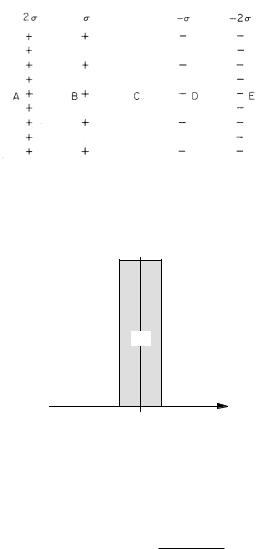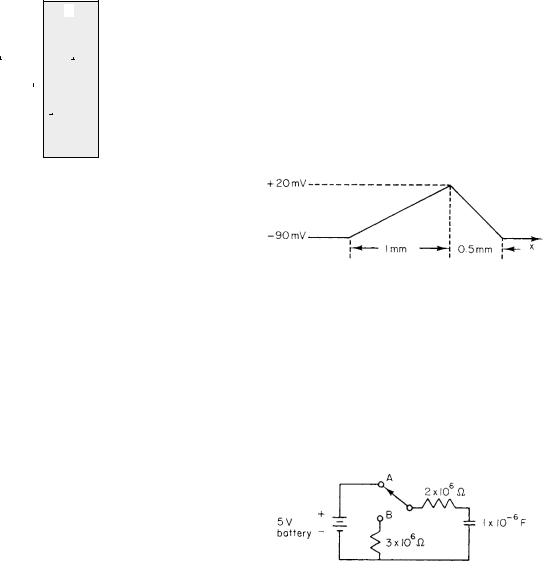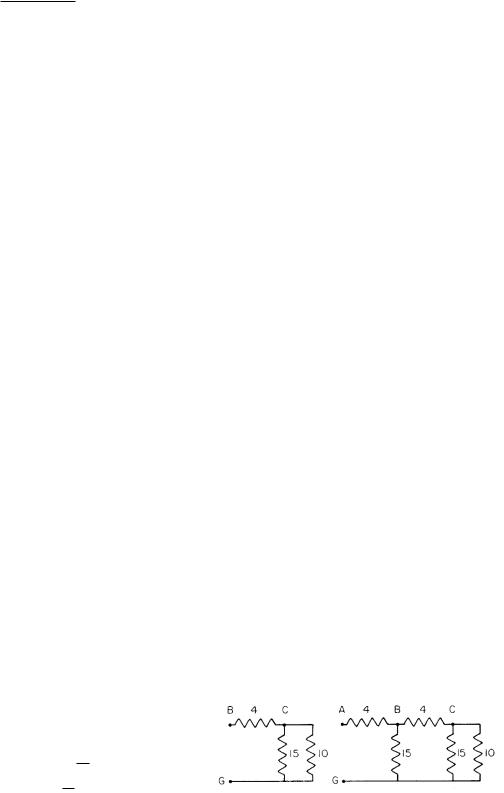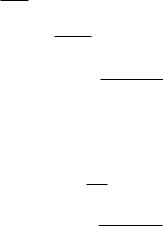
Intermediate Physics for Medicine and Biology - Russell K. Hobbie & Bradley J. Roth
.pdf



172 |
6. Impulses in Nerve and Muscle Cells |
|
|
||||||||||
Problem 37 This is a more general version of the pre- |
Problem 39 Calculate the values of the gates m, n, |
||||||||||||
vious problem, which can be applied directly to electro- |
and h for the resting membrane (v = −65 mV), us- |
||||||||||||
tonus when capacitance is neglected. Consider the ladder |
ing the Hodgkin and Huxley model. Recall that at rest, |
||||||||||||
shown, which represents an axon. R0 is the e ective re- |
m = m∞(v = −65 mV), etc. |
||||||||||||
sistance between the inside and outside of the axon to the |
|
||||||||||||
right of the section under consideration. The axon has |
Problem 40 If αn and βn depend on temperature ac- |
||||||||||||
been divided into small slices; Ri is the resistance along |
cording to Eq. 6.67, how do n∞ and τn depend on tem- |
||||||||||||
the inside of the axon in the small slice, and Rm is the |
perature? |
||||||||||||
resistance across the membrane in the slice. The resis- |
|
||||||||||||
tance outside the axon is neglected. Note that the resis- |
Problem 41 Calculate the resting membrane conduc- |
||||||||||||
tance looking into the axon to the right of points XX is |
tance per unit area for the resting membrane, using the |
||||||||||||
also R0. |
|
|
|
|
|
|
Hodgkin and Huxley model. Hint: jm = 0 at rest. Let |
||||||
|
|
|
|
|
|
|
|
|
|
|
|
v = vr +dv, where dv is small. Determine the steady-state |
|
|
|
|
|
|
|
|
|
|
|
|
|
jm as a function of dv. To keep things simple, ignore any |
|
|
|
|
|
|
|
|
|
|
|
|
|
changes to m, n, and h resulting from dv. |
|
|
|
|
|
|
|
|
|
|
|
|
|
Problem 42 In a voltage-clamp experiment, a wire of |
|
|
|
|
|
|
|
|
|
|
|
|
|
radius b is threaded along the interior of an axon of radius |
|
|
|
|
|
|
|
|
|
|
|
|
|
a. Assume the axoplasm displaced by the wire is pushed |
|
|
|
|
|
|
|
|
|
2 |
− |
out the end so that the cross-sectional area of the axon |
|||
(a) Show that R0 is given by a quadratic equation: R0 |
containing the wire remains πa2. The resistivities of wire |
||||||||||||
RiR0 − RiRm = 0 and that the solution is |
|
and axoplasm are ρw and ρa. Find the wire radius needed |
|||||||||||
|
|
|
|
1 |
|
|
|
|
|
|
|
||
|
R0 = |
Ri + (Ri2 + 4RiRm)1/2 . |
|
so that voltage changes along the axon are reduced by a |
|||||||||
|
|
|
|||||||||||
|
2 |
|
|
|
|
|
|
|
factor of 100 from what they would be without the wire. |
||||
(b) Show that the ratio of the voltage across one ladder |
Ignore the electrode surface impedance. |
||||||||||||
|
|||||||||||||
rung to the voltage across the immediately preceding rung |
Problem 43 A wire of resistivity ρw = 1.6 × 10−8 Ω m |
||||||||||||
is |
|
|
|
|
|
|
|
|
|
|
|
||
|
|
|
|
|
|
|
|
|
|
|
|
and radius w = 0.1 mm is threaded along the exact center |
|
|
|
|
|
|
|
|
|
|
|
|
|
of an axon segment of radius a = 1 mm, length L = 1 |
|
|
|
|
|
|
|
|
|
|
|
|
|
||
|
|
|
|
|
|
|
|
|
|
|
|
cm, and resistivity ρi = 0.5 Ω m. The axon membrane |
|
|
|
|
|
|
|
|
|
|
|
|
|
has conductance gm = 10 S m−2. Find numerical values |
|
|
|
|
|
|
|
|
|
|
|
|
|
for |
|
|
|
|
|
|
|
|
|
|
|
|
|
(a) the resistance along the wire, |
|
|
|
|
|
|
|
|
|
|
|
|
|
(b) the resistance of the axoplasm from the wire to the |
|
|
|
|
|
|
|
|
|
|
|
|
|
membrane, and |
|
|
|
|
|
|
|
|
|
RmR0 |
|
(c) the resistance of the membrane. |
|||
|
|
RmR0 + RmRi + RiR0 . |
|
|
|||||||||
(c) |
Now assume |
that Ri = ridx and Rm |
= |
|
|||||||||
1/(2πagmdx). Calculate R0 and the voltage ratio. Show |
|
||||||||||||
that the voltage ratio (as dx → 0) is |
|
|
|||||||||||
|
|
|
|
|
|
|
|
1 |
|
|
|
|
|
|
|
|
|
1 + (2πarigm)1/2dx . |
|
|
|||||||
(d) The preceding expression is of the form 1/(1 + x). |
Problem 44 If the voltage across an axon membrane is |
||||||||||||
For su ciently small x, this is approximately 1 − x. |
|||||||||||||
changed by 25 mV as in Fig. 6.34, how long will it take for |
|||||||||||||
Therefore, show that the voltage change from one rung |
|||||||||||||
to the next is dv = |
|
|
(2πa rigm)1/2dx v so that v obeys |
all the potassium to leak out if it continues to move at the |
|||||||||
|
|
|
|
|
|
− |
|
constant rate at which it first leaks out? Use the asymp- |
|||||
the di erential equation |
|
||||||||||||
|
|
|
|
|
|
|
|
|
|
|
|
totic value for the potassium conductance from Fig. 6.34. |
|
|
|
|
dv |
= −(2πarigm)1/2v. |
|
Use Table 6.1, and Fig. 6.3 for any other values you need. |
|||||||
|
|
|
|
|
|
||||||||
|
|
|
dx |
|
|
||||||||
Section 6.13 |
Section 6.14 |
Problem 38 Use the Hodgkin–Huxley parameters to an- |
Problem 45 Use the data of Fig. 6.40 to answer the |
swer the following questions. |
following questions about a nerve impulse in a squid axon |
(a) When v = vr , what are αn and βn? |
of radius a = 0.1 mm. |
(b) Show that dn/dt = 0 when n = 0.318. What is the |
(a) Estimate the peak sodium ion flux (ions m−2 s−1) |
resting value of gK ? |
and the total number of sodium ions per unit area that |
(c) At t = 0 the voltage is changed to −25 mV and held |
pass through the membrane in one pulse. |
constant. Find the new values of αn, βn, n∞, τn and the |
(b) By what fraction does the sodium concentration in |
asymptotic value of gK . |
the cell increase during one nerve pulse? |
(d) Find an analytic solution for n(t). Plot n and n4 |
(c) Estimate the peak potassium flux and total potas- |
for 0 < t < 10 ms. |
sium transport. |

